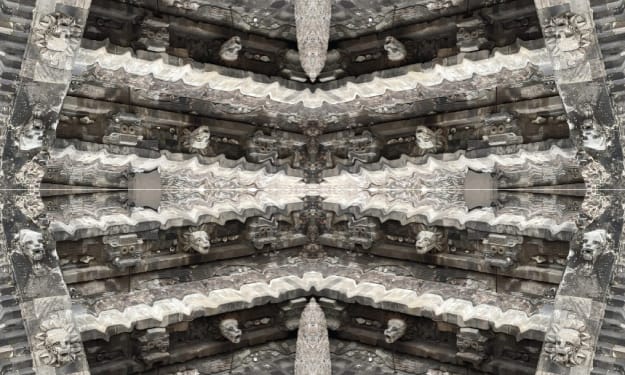Humanity's Odyssey Beyond the Stars
The Epic Journey of the Farthest Human-Made Object in the Universe

In the cold expanse of the cosmos, where the stars themselves seemed to huddle together for warmth, a tiny speck hurtled through the void. It was a testament to human ingenuity and the relentless pursuit of knowledge. This tiny speck was the farthest human-made object ever to venture into the universe - the Voyager 1 spacecraft.
The year was 1977 when Voyager 1 was launched from Cape Canaveral in Florida. It was a time of hope and discovery, a time when the world looked to the stars with a sense of wonder and anticipation. Voyager 1 was not alone; its twin, Voyager 2, embarked on the same journey, each carrying a golden record that held the collective voice of Earth. These records were a message to the cosmos, a time capsule of human culture, music, and greetings in 55 different languages, a message that would travel beyond the stars.
As Voyager 1 left the Earth's atmosphere, it began its long and solitary journey through the vastness of space. Its primary mission was to study the outer planets of our solar system, and it did so with remarkable precision. Stunning images of Jupiter and its swirling storms, the icy rings of Saturn, and the mysterious blue world of Uranus were beamed back to Earth, filling the hearts of scientists and dreamers alike with awe.
But Voyager 1 was not content with merely fulfilling its initial mission. It had a grander destiny, one that would take it beyond the boundaries of our solar system and into the unknown. In 1990, the spacecraft turned its cameras back towards the Earth, capturing the iconic "Pale Blue Dot" image. In that tiny pixel, Earth appeared as a minuscule speck suspended in a sunbeam, a poignant reminder of our place in the universe.
Voyager 1's instruments measured the increasing distance from Earth, and in 2012, it achieved a historic milestone. It became the first human-made object to cross the boundary known as the heliopause, the point where the influence of our Sun's solar wind gives way to the interstellar medium. Voyager 1 was now in truly uncharted territory, and its mission had transformed into a journey to the stars themselves.
The spacecraft continued to transmit valuable data, even as its power supply dwindled. It revealed that the space beyond our solar system was not empty but filled with charged particles and magnetic fields. Voyager 1 had become an ambassador of humanity, silently drifting through the cosmos while still communicating with its creators on Earth.
As decades turned into half-centuries, Voyager 1 carried on, ever farther from its home planet. It became a symbol of endurance and human achievement, a testament to what can be accomplished when we reach for the stars. Its golden record continued to carry the sounds of laughter, music, and greetings from Earth, waiting for the day when it might encounter another intelligent civilization.
The spacecraft's systems were gradually shutting down, one by one, as its plutonium power source decayed. It could no longer send back the breathtaking images that had captivated humanity for so long. But it still whispered its presence to us through the faint signals it transmitted back to Earth.
Then, on September 12, 2013, Voyager 1 sent a signal that stunned scientists and sparked a renewed sense of wonder. It detected a change in cosmic rays, a sign that it had finally crossed the threshold into interstellar space. Voyager 1 had officially left our solar system and entered the vast expanse of the Milky Way.
The news of Voyager 1's achievement reverberated around the world. It was a moment of triumph for science, a reminder of the enduring human spirit that seeks to explore and understand the universe. The spacecraft had accomplished what no other had before, and it was still going, still exploring, and still sending back valuable data.
Today, Voyager 1 continues its solitary journey through interstellar space. Its power is waning, and its instruments will eventually fall silent, but its legacy will endure. It will be a billion years or more before it encounters another star system, and when it does, it will carry with it the story of humanity, etched in the grooves of its golden record.
The farthest human-made object reminds us of our boundless curiosity, our capacity for exploration, and our place in the cosmos. Voyager 1 is a testament to what we can achieve when we reach beyond our limits, and it serves as a beacon of hope for future generations who dream of venturing even farther into the universe.
In the end, Voyager 1's journey is not just a physical one through space but a symbolic one that speaks to the enduring human quest for knowledge and our unrelenting drive to explore the farthest reaches of the cosmos. It is a journey that will continue to inspire and captivate us, even as it travels beyond the stars.
About the Creator
Esther Anima
My stories are not just ink on paper; they are the echoes of my dreams and the whispers of my deepest passions. Join me on this literary voyage, and together, we'll explore the vast universe of human experience, one word at a time.
Enjoyed the story? Support the Creator.
Subscribe for free to receive all their stories in your feed. You could also pledge your support or give them a one-off tip, letting them know you appreciate their work.






Comments (1)
Great work